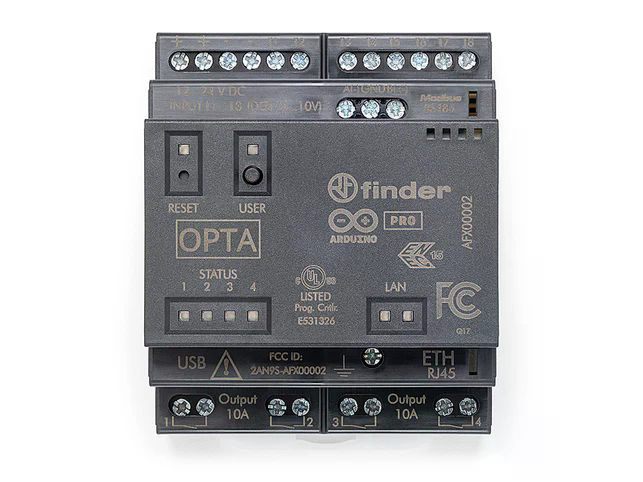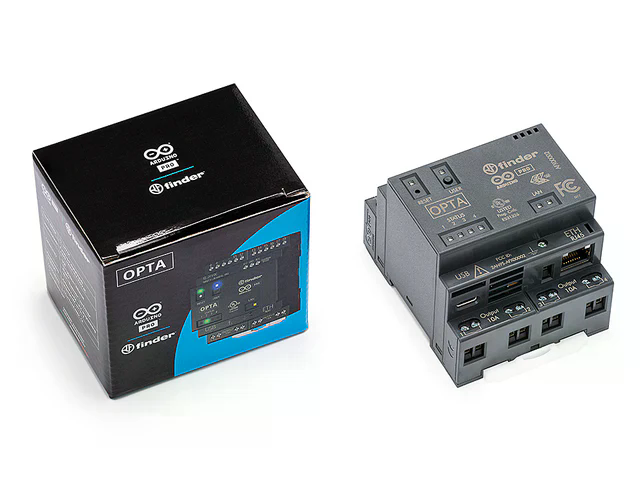Opta RS485
Unlock the power of Arduino’s micro PLC, developed with Finder, for smart control in factories, offices, and homes. Combine intuitive programming with industrial reliability to automate processes with ease and scale your projects confidently.
DESCRIPTION
Arduino Opta: The Secure Micro PLC for Industrial IoT
Arduino Opta is a compact and reliable micro PLC designed for industrial and building automation. Created in collaboration with Finder, it blends the power of industrial-grade hardware with the simplicity and flexibility of the Arduino ecosystem.
At its core, the Opta features the STM32H747XI dual-core Arm® Cortex®-M7 + M4 MCU, enabling real-time control, monitoring, and predictive maintenance. With support for standard PLC languages and Arduino programming, it’s ideal for professionals who want to scale their automation projects with minimal complexity.
Designed for durability and security, Opta includes built-in support for OTA firmware updates and hardware based encryption via a secure element, with full X.509 Standard compliance. Connectivity is effortless thanks to Ethernet, Wi-Fi®, and Bluetooth® Low Energy interfaces. And with intuitive dashboards via Arduino Cloud or third party platforms, real-time monitoring and remote management are always within reach.
Reliable, connected, and easy to use Arduino Opta brings Industrial IoT to your fingertips.
Program it with the Arduino PLC IDE
The Arduino PLC IDE brings the power of industrial automation to your fingertips. Whether you're starting from scratch or migrating existing applications, you can choose from any of the five IEC 61131-3 standard languages Ladder Diagram, Functional Block Diagram, Structured Text, Sequential Function Chart, or Instruction List to develop and deploy PLC applications on the Arduino Opta or Portenta Machine Control.
Key Benefits:
- Fast and intuitive development with ready-to-use Arduino sketches, libraries, and tutorials
- Optional support for IEC 61131-3 PLC programming standards
- Fieldbus-ready with Modbus TCP (Ethernet) and Modbus RTU (RS485) integration
- Effortless IoT connectivity via Ethernet, Wi-Fi®, and Bluetooth® Low Energy
- Real-time monitoring with Arduino Cloud dashboards or third-party platforms
- Secure by design with onboard secure element and X.509 Standard compliance
- OTA firmware updates and cloud-based device management
- Industrial-grade power switching with 4 x 2.3 kW high-power relays
- Built for durability and reliability with industrial certifications and Finder’s switching technology
- Easy DIN rail installation for seamless integration into control panels
Arduino Opta: Industrial and Building Automation Made Simple
Arduino Opta makes it easy to bring automation to any environment. Whether you're upgrading existing systems or building from scratch, this compact micro PLC seamlessly integrates with machines, sensors, devices, and production lines. Its compatibility with the broader Arduino ecosystem including smart modules, system-on-modules (SOMs), and gateways enables fully customizable, scalable end-to-end solutions.
Built for Security and Reliability
Designed with industrial-grade durability in mind, Opta supports secure over-the-air (OTA) firmware updates and ensures end to end data protection via its onboard secure element and compliance with the X.509 standard.
Boost Your Industrial Automation
Use Opta alongside load cells or vision systems to streamline manufacturing workflows like confirming product weight as items move down a conveyor. Synchronize labeling processes via NTP or monitor systems in real time through an HMI or remotely with Arduino Cloud dashboards. And with its machine learning capabilities, Opta enables predictive maintenance by detecting anomalies before they become problems.
Smart Automation for Buildings and Offices
Arduino Opta enables intelligent control of building and office systems, making automation both accessible and efficient. From roller blinds and sun shades to irrigation, lighting, and HVAC systems everything can be securely connected and controlled remotely.
Automation can be triggered by simple schedules (like time of day or day of the week), or based on complex data from sensors and external sources: indoor air quality, weather forecasts, energy consumption patterns, and more. The result is enhanced comfort, increased efficiency, lower energy costs, and a reduced environmental footprint all with the reliability and flexibility of the Arduino ecosystem.







